Ijraset Journal For Research in Applied Science and Engineering Technology
- Home / Ijraset
- On This Page
- Abstract
- Introduction
- Conclusion
- References
- Copyright
Analysing the Impact of Additives on the Strength Parameters of 3D Printed Concrete
Authors: Abhishek Jadhav, Aishwarya Jadhav, Omkar Bhalerao, Sonali Jadhav, Tejaswini Bira, Lalit Desale, Praful Shinkar
DOI Link: https://doi.org/10.22214/ijraset.2024.62917
Certificate: View Certificate
Abstract
3D Printing is an additive manufacturing process. 3D concrete printing is an innovative construction technique that uses computer-controlled machines to create structures layer by layer. This method allows for intricate designs and shapes to be produced with precision. The process is efficient and can reduce material waste, making it a sustainable option for construction projects. It doesn\'t require the use of formwork and also requires less labour. Silica sand is a waste product of the foundry and paint industry. It is known for its uniform particle size, which can result in a more consistent and even finish in construction projects. Additionally, silica sand is free of impurities like clay and organic matter, making it ideal for use in manufacturing high-quality concrete and mortar. Its angular shape also provides better bonding properties, improving the overall strength and durability of the construction material. It can be a viable alternative to river sand in the production of concrete. Our project deals with the use and optimization of silica sand as an alternative to river sand in the production of 3D Printed Concrete.
Introduction
I. INTRODUCTION
3D printing construction technology also known as additive construction, refers to the process of using 3D printing techniques to build structures layer by layer. It is an innovative approach to building construction that has the potential to revolutionize the industry by offering faster, more cost-effective, and customizable construction solutions. This technology involves the use of large-scale 3D printers that can deposit various materials such as sand, cement, fly ash, admixtures to construct buildings, houses, bridges, and other architectural elements. In this project River sand, sand silica, cement, fly ash has been used to build the sample to enhance the properties of that concrete by using various admixtures. Additives play a crucial role in modifying the properties of 3D printed concrete. These additives aimed at enhancing strength, durability, workability, and other performance metrics. Understanding the impact of additives on the strength parameters of 3D printed concrete is vital for optimizing the printing process and ensuring structural integrity in real-world applications. This paper aims to analyze the effects of different additives on the strength parameters of 3D printed concrete. By systematically evaluating the influence of various additives on compressive strength, durability and other relevant parameters, we can gain insights into their effectiveness and potential synergies. Moreover, this analysis can inform the development of optimized additive formulations tailored to specific construction requirements and printing technologies. Ultimately, the findings of this research will not only contribute to the academic understanding of 3D printed concrete but also have practical implications for engineers, architects, and construction professionals seeking to leverage additive manufacturing technologies for sustainable and resilient infrastructure development.
A. Problem Identification
Traditional concrete construction methods often encounter challenges in achieving optimal strength parameters while maintaining efficiency and cost-effectiveness. Factors such as pumpability, extrudability, and buildability significantly influence the success of 3D printing concrete structures. Existing gaps in additive analysis and its impact on strength parameters necessitate a systematic investigation to address these challenges. The present innovation aims to bridge these gaps by comprehensively analyzing the impact of additives on the strength parameters of 3D printed concrete.
B. Objectives of Project
- To investigate the influence of admixtures on 3D printing process parameters such as pumpability, extrudability, buildability.
- To develop various concrete mix design by adjusting properties of sand silica to achieve desired strength parameters.
- To Investigate and evaluate the parameters of 3D printed concrete.
II. IDENTIFY, RESEARCH AND COLLECT IDEA
A. Research
By optimizing concrete mix designs and incorporating suitable admixtures, the innovation seeks to enhance pumpability, extrudability, and buildability while ensuring desirable strength characteristics. Through meticulous experimentation and data analysis, the innovation addresses limitations in traditional construction methods and offers a viable solution for efficient and customizable concrete construction.
B. Introduction
3D printing construction technology also known as additive construction refers to the process of using 3D printing techniques to build structures layer by layer. It is an innovative approach to building construction that has the potential to revolutionize the industry by offering faster, more cost-effective, and customizable construction solutions. This technology involves the use of large-scale 3D printers that can deposit various materials such as sand, cement, fly ash, admixtures to construct buildings, houses, bridges, and other architectural elements. In this project River sand, sand silica, cement, fly ash has been used to build the sample to enhance the properties of that concrete by using various admixtures.
This paper aims to analyze the effects of different additives on the strength parameters of 3D printed concrete. By systematically evaluating the influence of various additives on compressive strength, durability and other relevant parameters, we can gain insights into their effectiveness and potential synergies. Moreover, this analysis can inform the development of optimized additive formulations tailored to specific construction requirements and printing technologies.
C. Methodology
Following are the various steps that we decided to use for the successful conduction of our project. The steps are mentioned in detail below.
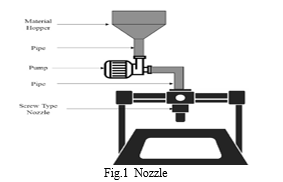
D. Mechanism
The mechanism involves the precise layering of construction materials based on Newton’s law obeys, digital designs. Key components of the 3D printer and their functions includeExtruder: Deposits and layers the construction material.
- Build Platform: Supports the printed structure during construction.
- Controller: Manages the movement of the extruder and build platform.
E. 3D Printer Components
- Extruder: Responsible for feeding and melting the construction material.
- Build Platform: The surface on which the construction material is deposited layer by layer
- Controller Board: Manages the movement of the extruder and build platform, ensuring precision.
- Supply: Provides the necessary power for the entire 3D Printing process.
- Nozzle: Nozzles come in various diameters, commonly Ranging from 0.2mm to 1.0mm. The nozzle diameter affects layer resolution and printing speed. Smaller nozzles(e.g., 0.4mm) are often used for detailed prints, while larger nozzles may be used for faster, less detailed prints.
- Mixing Pump: A mixing pump, is not a standard component in most 3D printers. However, some specialized 3D printers do exist that incorporate multiple extruders or hot ends, allowing for the mixing of different filaments.
- Pressure Pump: Pressure monitoring contributes to the overall safety of the 3D concrete printing process by ensuring that the equipment operates within safe limits and that there is no risk of over-pressurization
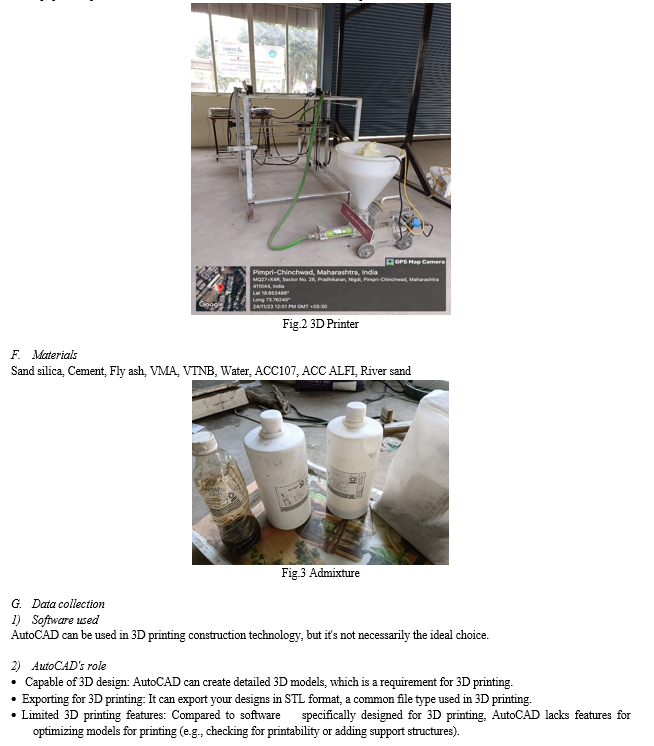
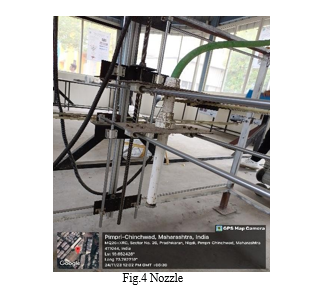
H. Controlling
Using sensors embedded within the concrete during the 3D printing process is an emerging technique to achieve greater control and quality in construction. Here's how it works
Sensor Types
- Pressure Sensors: Placed near the nozzle or within the printing line, these monitor the flow of concrete. Consistent pressure ensures proper deposition and identifies blockages that could ruin the print .
- Height Sensors: These can be ultrasonic or laser-based and measure the deposition height of each layer. This feedback allows for real-time adjustments to the nozzle distance for a uniform and precise structure
I. Motors and Movement:
Similar to traditional 3D printers, concrete printers use stepper motors or servo motors to control the movement of the print head (nozzle) along the X, Y, and Z axes. Stepper motors offer precise movement in specific increments, ideal for building up layers of concrete. Servo motors provide more control over speed and position, which can be beneficial for complex printing paths.
J. Control System
- A central control unit, often a computer running specialized software, receives the 3D model data (usually converted to a toolpath).
- This software translates the model into a series of instructions for the motors, specifying the precise movement for each layer of concrete deposition.
- The control unit sends these instructions to the motor drivers, which regulate the power delivered to the motors, ensuring they move according to the program.
K. Working mechanism
The mechanism involves the precise layering of construction materials based on Newton’s law obeys, digital designs. Key components of the 3D printer and their functions include:
- Extruder: Deposits and layers the construction material.
- Build Platform: Supports the printed structure during construction.
- Controller: Manages the movement of the extruder and build platform.
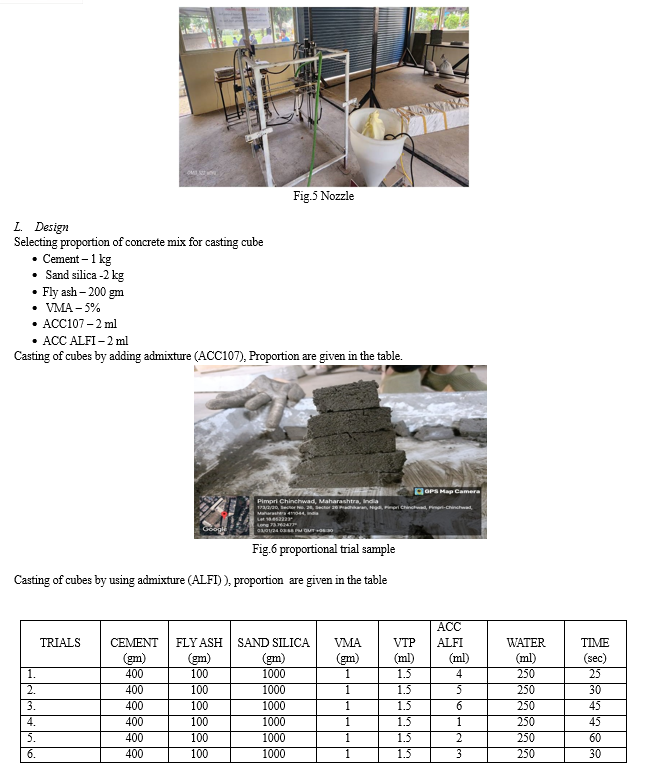
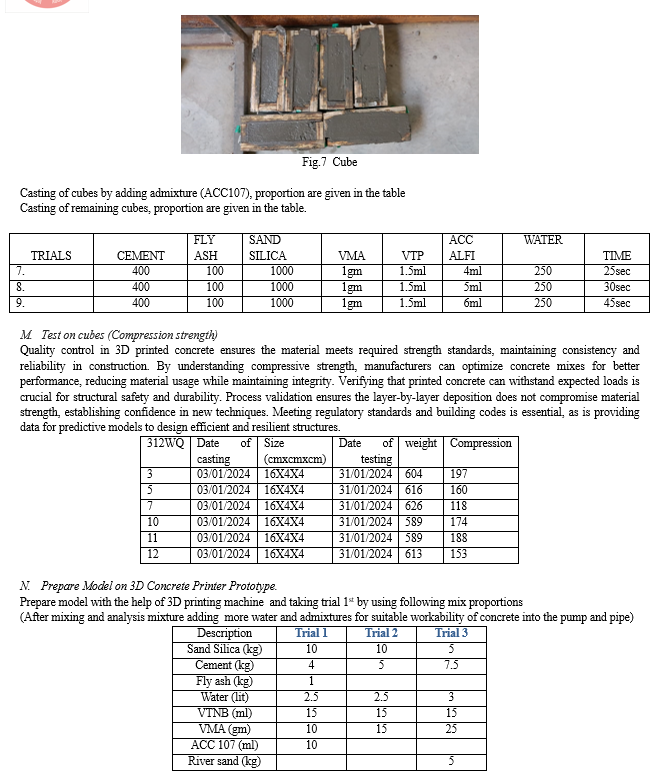

III. TEST AND RESULTS
A. Rebound Hammer Test On Castings
The rebound hammer method provides a convenient and rapid indication of the compressive strength of concrete by means of establishing a suitable correlation between the rebound index and the compressive strength of concrete.Castings were made of the 50% replacement of silica sand to river sand. Non-destructive testing was done using a rebound hammer. All readings were taken at 0° inclination.

Conclusion
From our work on this project called as 3dpc. We conclude the point on that topic. 1) After casting and testing the 6 block to finalize the proportion is silica sand is a viable alternative to river sand. 50% replacement of river sand by silica sand yields the highest compressive and flexural strength. 2) After 3-D printing trials, finally its achieved 0.5 water content ratio, VMA & VTMB admixture 1-10 % of cement. 3) After successfully printing and casting, we perform the test and we got better result than conventional concrete. 4) After taking the rebound hammer test to the layer of sample, we got the proper reading for future cracks. • Therefore, we finalise that this proportion can be used for the construction using 3D printer A. Future Scope of the Work 1) This project also can be used in future by changing the Nozzle diameter. 2) The Durability test test like RCPT & Freeze-thaw can be done in future. 3) Additional alternate materials used in 3D concret
References
[1] Lyu F, Zhao D, Hou X, Sun L, Zhang Q., “Overview of the Development of 3D-Printing Concrete: A Review.” Applied Sciences, Vol-11, Issue-21,2021. [2] Sharma, U., Khatrib, A., & Kanoungoc, A. (2014). “Use of Micro-silica as Additive to Concrete-state of Art”., Issue-Jan 2014. [3] Zhang, Y., Zhang, Y., Yang, L., Liu, G., Chen, Y., Yu, S., & Du, H. (2021). “Hardened properties and durability of large”, Vol-54,Article-45,Issue- 01 March 2022 [4] Rafat Siddique, gurpreet Singh, Rafik Belarbi, Karim Air-Mokhtar, Kunal “Comparative investigation on the influence of spent foundry sand as partial replacement of fine aggregate on the properties of two grades of concrete”, Elsevier, 2015, 2, 43-49. [5] Manuel Hambach, Dirk Volkmer; Properties of 3D-printed fiber reinforced Portland cement paste Cement and Concrete - Elsevier, 2017 [6] S. Raghavendra, I Praveen Reddy, Dr. Archana Dongre Fibre Reinforced Concrete- a case study, Research Gate, 2020 [7] Shantanu Bhattacherjee, V. Rahul, Manu Santhanam, 2020 Concrete 3d printing progress worldwide and in India, Indian concrete journal, 2020 [8] Yekai Yang , Chengqing Wu, Zhongxu Liu, Jun Li, Ting Yang, Xiquan Jiang, Characteristics of 3D-printing ultra-high-performance fiber-reinforced concrete under impact loading International Journal of Impact Engineering, 2022. [9] Gopal Mishra Fibre Reinforced concrete - Types, Properties and Advantages of Fibre Reinforced Concrete.\" The Constructor- Researchgate , 2017 [10] Phuong Tran, Luong Pham, Jay Sanjayan Steel fibers reinforced 3D printed concrete Influence of fiber sizes on mechanical performance\", Construction and Building Materials, Elsevier, April 2020 [11] Pshtiwan Shakor, Shami Nejadi, Gavin Paul A Study into the Effect of Different Nozzle Shapes and Fibre-Reinforcement in 3D Printed Mortar Materials , MDPI 2019. [12] Sooraj A.O. Nair, Subhashree Panda Critical examination of the influence of material characteristics and extruder geometry on 3D printing of cementitious binders Cement and Concrete Composites, Elsevier , 2020 [13] Lian-Hua Ma, Kun Zhang A critical examination of influence of material characteristics and extruder geometry on 3D printing of cementitious binders Journal of Composite Materials, Elsevier, 2022. [14] Pshtiwan Shakor, Shami Nejadi, Gavin Paul Using Polypropylene Fibers in Concrete to achieve maximum strength\' Research Gate 2018. [15] Wang, Y., Qiu, L.-c., Chen, S.-g., & Liu, Y. (2024). 3D concrete printing in air and underwater: A comparative study on the buildability and interlayer adhesion. Construction and Building Materials, 411, 134403. [16] Liu, D., Zhang, Z., Zhang, X., & Chen, Z. (2023). 3D printing concrete structures: State of the art, challenges, and opportunities. Construction and Building Materials, 405, 133364. [17] Zhengyuan Chen, Shutong Yang, Qi Liu, Mingqi Xu, Sheng Wang, Tian Lan,Closed-form fracture model for evaluating crack resistance of 3D printed fiber-reinforced alkali-activated slag/fly ash recycled sand concrete,Journal of Building Engineering,Volume 86,2024,108964, [18] Liu, Z., Li, M., Moo, G. S. J., Kobayashi, H., Wong, T. N., & Tan, M. J. (2023). Effect of Nanostructured Silica Additives on the Extrusion-Based 3D Concrete Printing Application. [19] Sikora, P., Chougan, M., Cuevas, K., Liebscher, M., & Mechtcherine, V [20] Sam, V. S., Hemalatha, G., Jebadurai, V. S., Arunraj, E., & Rani, J. J. (2023). Nano Silica Particles as A Structural Build Up Agent for 3D Printing Cement Paste with Additional Accelerators. [21] Nematollahia, B., Xia, M., & Sanjayanc, J. (2017). Current Progress of 3D Concrete Printing Technologies. This paper reviews extrusion [22] Shahzad, Q., Umair, M., & Waqar, S. (2022). Bibliographic analysis on 3D printing in the building and construction industry [23] Liu, H., Egbe, K. J. I., Wang, H., Nazar, A. M., Jiao, P., & Zhu, R. (2021). A Numerical Study on 3D Printed Cementitious Composites Mixes Subjected to Axial Compression.
Copyright
Copyright © 2024 Abhishek Jadhav, Aishwarya Jadhav, Omkar Bhalerao, Sonali Jadhav, Tejaswini Bira, Lalit Desale, Praful Shinkar. This is an open access article distributed under the Creative Commons Attribution License, which permits unrestricted use, distribution, and reproduction in any medium, provided the original work is properly cited.

Download Paper
Paper Id : IJRASET62917
Publish Date : 2024-05-29
ISSN : 2321-9653
Publisher Name : IJRASET
DOI Link : Click Here
 Submit Paper Online
Submit Paper Online

